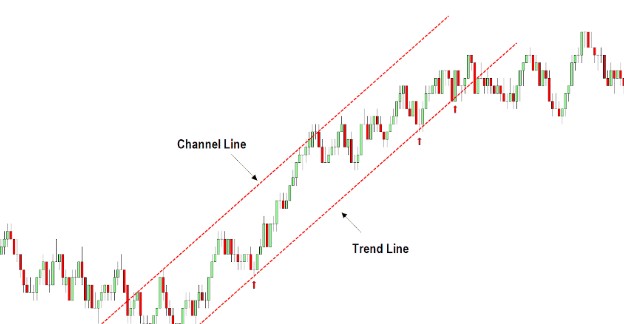4.3 Support & Resistance: Trend Line Channels
In this lesson, we’ll dive into price channels, a more advanced form of trend line used in technical analysis. Price channels consist of two parallel (or nearly parallel) trend lines that frame the price action of a currency pair. These lines help visualize the slope and range of a trend—either rising, falling, or flat.
Compared to single trend lines, channels provide more insight, especially when both boundaries of the trend are clear and symmetrical. Trading within well-defined channels can offer better trading opportunities by improving entry and exit decisions.
📘 What Are Forex Price Channels?
Price channels—also called tunnels or sleeves—are simply two trend lines that move in parallel and contain most of the price action. These channels give traders a visual framework for spotting areas of support and resistance, based on the following:
- Upper boundary: resistance (where price tends to bounce down)
- Lower boundary: support (where price tends to bounce up)
Depending on market conditions, you may see three types of channels:
- 🔺 Rising Channels (uptrend)
- 🔻 Falling Channels (downtrend)
- ⬜ Flat Channels (sideways range)
✅ Why Use Price Channels Instead of Single Trend Lines?
While a single trend line can show the general direction of a trend, price channels add depth by showing the full range of movement. This can help you:
- Identify optimal entry points near the lower channel line in an uptrend.
- Plan target exits near the upper channel line in a rising channel.
- Spot trend reversals when price breaks out of the channel range.
Price channels help you anticipate not just where price is going, but also how far it’s likely to go within a structured boundary.
📊 How to Use Price Channels in Trading
Here’s a typical trading strategy within a rising or falling channel:
Long Position (Buy Trade)
- Enter near the lower trend line (support)
- Exit near the upper trend line (resistance)
Short Position (Sell Trade)
- Enter near the upper trend line (resistance)
- Exit near the lower trend line (support)
Before acting on these setups, always check for IRATE factors (Indicators, Round Numbers, Age, Tested levels, and Event-based confluence) to confirm trade quality.
⚠️ Avoid Trading Against the Channel’s Trend
Although it may seem profitable to “trade the range” (buy low, sell high), trading against a strong trend inside a channel—especially one that is steep and narrow—can be risky. Here’s why:
- In a falling channel, trying to go long (buy) may lead to losses as resistance keeps moving lower.
- In a rising channel, trying to short (sell) could result in quick stop-outs as support climbs higher.
Unless:
- The slope of the channel is gentle, and
- The channel is wide enough to allow price room to move…
…it’s best to trade with the trend, not against it.
📉 Trend Reversals Using Channels
One major advantage of price channels over simple trend lines is their stronger signals for trend reversals. For example:
- A breakout above the upper line in a falling channel signals a potential reversal to an uptrend.
- A breakdown below the lower line in a rising channel signals a possible shift to a downtrend.
This is because breaking an entire price range (a channel) requires a more decisive market shift than simply breaking a single line.
🧠 Final Thought
Although price channels are incredibly useful, drawing them correctly still requires some subjective judgment. Traders may not agree on exact placement, which is why these should always be seen as zones, not fixed prices.
Use them in conjunction with other tools for higher accuracy—and remember, context matters.

 English
English 


